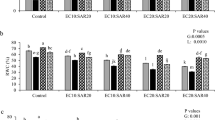Summary
Sand culture pot experiments were carried out with Proposis seedlings in the greenhouse on a nitrogen free nutrient solution with increasing levels of sodium chloride. All species tolerated a 6,000 mg/l salinity with no reduction in growth.P. velutina was the only species that poorly tolerated the 12,000 mg/l salinity level.P. articulata, P. pallida, andP. tamarugo tolerated 18,000 mg/l NaCl with little reduction in growth and grew slightly in a salinity (36,000 mg/l NaCl) greater than seawater. This is the first legume known to grown in salinities equivalent to seawater.
Similar content being viewed by others
References
Burkart, A. 1976 A monograph of the genusProsopis (Leguminosae subfam.Mimosoideae). J. Arnold. Arb.57, 217–249 and 450–525.
Eaton, F. M. and Bernardin, J. E. 1962 Soxhlet-type automatic sand cultures. Plant Physiol.37, 357–358.
Felker, P. 1979 Mesquite—An all-purpose leguminous arid-land tree.In New Agricultural Crops. Ed. G. A. Ritchie. AAAS Symp. Vol.38, Westview Press, Golden, Colorado.
Felker, P. and Clark, P. R. 1980 Nitrogen fixation (acetylene reduction) and cross-inoculation in 12 (Prosopis) mesquite species. Plant and Soil57, 177–186.
Felker, P., Cannell, G. H. and Clark, P. R. 1981 Variation in growth among 13 Prosopis (mesquite) species. Exp. Agric.17, 209–218.
Felker, P. and Clark, P. R. 1981 Rooting of mesquite (Prosopis) cuttings. J. Range Manage.In press.
Hsaio, T. C. 1973 Plant responses to water stress. Annu. Rev. Plant Physiol.24, 519–570.
Richards, L. A. 1954 Diagnosis and improvement of saline and alkali soils. U.S. Salinity Lab. Agric. Handbook No.60, USDA. 11 and 67.
Somers, G. F. 1979 Natural halophytes as a potential resource for new salt-tolerant cropsIn The Biosaline concept. Ed. A. Hollaender. Plenum Press, New York, pp 101–115.
Summerfield, R. J., Huxley, P. A. and Minchin, F. R. 1977 Plant husbandry and management techniques for growing grain legumes under simulated tropical conditions in controlled environments. Exp. Agric.13, 81–92.
Author information
Authors and Affiliations
Rights and permissions
About this article
Cite this article
Felker, P., Clark, P.R., Laag, A.E. et al. Salinity tolerance of the tree legumes: Mesquite (Prosopis glandulosa var.torreyana, P. velutina andP. articulata) Algarrobo (P. chilensis), Kiawe (P. pallida) and Tamarugo (P. tamarugo) grown in sand culture on nitrogen-free media. Plant Soil 61, 311–317 (1981). https://doi.org/10.1007/BF02182012
Received:
Revised:
Issue Date:
DOI: https://doi.org/10.1007/BF02182012




